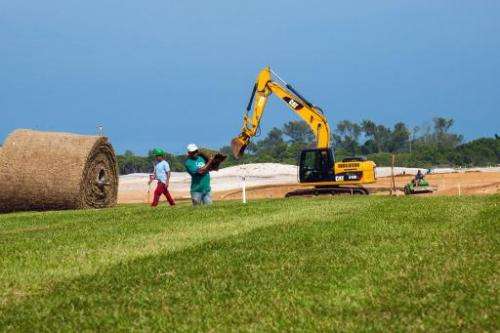Rio's Olympic golf course in legal bunker

The return of golf to the Olympics after what will be 112 years by the time Rio hosts South America's first Games in 2016 comes amid accusations environmental laws were got round to build the facility in a nature reserve, horrifying ecologists.
Golf made a brief foray into the history of the Games with appearances in 1900 and 1904.
But its appearance on the Rio timetable has dragged city authorities as well as the course developer into a legal spat.
Ecologists have decried the construction as an environmental crime meriting a legal challenge to force design concessions limiting the site's impact on the local ecosystem.
When the International Olympic Committee announced in 2009 that Rio had won hosting rights they added that golf was back and that rugby sevens would be featuring as a new Olympic sport.
The course is being built to Olympic specifications on private land in the western Rio suburb of Barra de Tijuca, which host the bulk of Olympic events.
But campaigners are aghast at the choice of a site within the (APA), whose vegetation had already suffered from decades of mining activity nearby before authorities slapped a preservation order on it, opening the way to regeneration.
The Rio prosecutor suggested the developers create a 400-meter (yards) wide corridor home to thick vegetation and rich fauna around the course which would allow wildlife to reach wooded and wetland areas either side.
The prosecutor initially called for the suspension of the construction license before urging modifications of course designer Guy Hanse's plans.
- 'Legacy mode' -
A Wednesday hearing ruled the project should continue, with the proviso it includes the bulk of the mooted 400-meter corridor.
Lawyers for constructors and land owners Fiori protested that means at least five holes will need revamping, putting the heat on as they bid to ready the site in time for a test event next year.
Prosecutor Marcus Leal rejected the firm's offer to limit modifications to three holes, citing the need to preserve the area's ecosystem.
The city hall said it would consider accepting a course in "legacy mode"—that is leaving the site as it is for the Games and undertaking modifications afterwards.
Magistrate Eduardo Klausner urged Fiori and the mayor's office to table a new proposal inside 45 days which would meet Olympic requirements while keeping environmental damage to a minimum for the 60 million reais ($27 million) project, which began a year behind schedule.
By mid-August it was 59 percent complete.
Local pressure group "Golf for Who" has loudly condemned the use of the site for the Games.
- Bureaucratic 's-
Most Rio residents do not closely follow a sport regarded as being for rich people—there are just two private courses in the city.
The one being fashioned for the Games will be Rio's first public course and organizers hope it can give the discipline a boost.
The organizing committee and the International Golf Federation (FIG) considered neither private course was suitable for 2016, though one has previously hosted pro events.
They considered "they did not have adequate conditions to host the competition," a spokesman for Rio's Municipal Olympic Company (EOM) told AFP.
Citing the need for a new course they plumped for the site within the Marapendi protection area.
In awarding the license the Rio city hall pushed through amendments in the legal framework covering conservation in the protection area, changing the phrase "wildlife preservation zone," which ruled out site development, to "conservation zone".
The latter allows some scope for construction, Isabel Lobato, forestry engineer and Rio's former conservation and environmental protection secretary told AFP.
She left her post in February over her opposition to the golf course, maintaining it was not in keeping with preservation of the area.
- Controversial seeding -
"Just sowing the grass does not meet the objective of wildlife preservation as you then prevent any process of (environmental) recovery" from work at the site, she maintains.
Roberto Bastos Rocha, who served as site assessor under Lobato, said the city hall had at the outset "vetoed" the course project but then gone ahead.
"We explained it was not viable—but they told us it was not possible to make modifications," Rocha said.
The Rio prosecutor had based a call for the project's suspension on contributions to the debate by Lobato, Rocha and biologist Sonia Peixoto. They cited errors in the granting of a permit to develop the site and decried damage to its tropical vegetation.
The city hall did not grant a request from AFP to visit the site. In August, Games organizers said the grass had been sown and would take some 11 months to grow.
Pre-Games course testing is scheduled for 2015—if the organizers can hole out of their legal bunker.
© 2014 AFP


















